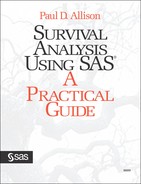What Is Survival Data?
Survival analysis was designed for longitudinal data on the occurrence of events. But what is an event? Biostatisticians haven’t written much about this question because they have been overwhelmingly concerned with deaths. When you consider other kinds of events, however, it’s important to clarify what is an event and what is not. I define an event as a qualitative change that can be situated in time. By a qualitative change, I mean a transition from one discrete state to another. A marriage, for example, is a transition from the state of being unmarried to the state of being married. A promotion consists of the transition from a job at one level to a job at a higher level. An arrest can be thought of as a transition from, say, two previous arrests to three previous arrests.
To apply survival analysis, you need to know more than just who is married and who is not married. You need to know when the change occurred. That is, you should be able to situate the event in time. Ideally, the transitions occur virtually instantaneously, and you know the exact times at which they occur. Some transitions may take a little time, however, and the exact time of onset may be unknown or ambiguous. If the event of interest is a political revolution, for example, you may know only the year in which it began. That’s all right so long as the interval in which the event occurs is short relative to the overall duration of the observation.
You can even treat changes in quantitative variables as events if the change is large and sudden compared to the usual variation over time. A fever, for example, is a sudden, sustained elevation in body temperature. A stock market crash could be defined as any single-day loss of more than 20 percent in the market index. Some researchers also define events as occurring when a quantitative variable crosses a threshold. For example, a person is said to have fallen into poverty when income goes below some designated level. This practice may not be unreasonable when the threshold is an intrinsic feature of the phenomenon itself or when the threshold is legally mandated. But I have reservations about the application of survival methods when the threshold is arbitrarily set by the researcher. Ideally, statistical models should reflect the process generating the observations. It’s hard to see how such arbitrary thresholds can accurately represent the phenomenon under investigation.
For survival analysis, the best observation plan is prospective. You begin observing a set of individuals at some well-defined point in time, and you follow them for some substantial period of time, recording the times at which the events of interest occur. It’s not necessary that every individual experience the event. For some applications, you may also want to distinguish different kinds of events. If the events are deaths, for example, you might record the cause of death. Unlike deaths, events like arrests, accidents, or promotions are repeatable; that is, they may occur two or more times to the same individual. While it is definitely desirable to observe and record multiple occurrences of the same event, you need specialized methods of survival analysis to handle these data appropriately.
You can perform survival analysis when the data consist only of the times of events, but a common aim of survival analysis is to estimate causal or predictive models in which the risk of an event depends on covariates. If this is the goal, the data set must obviously contain measurements of the covariates. Some of these covariates, like race and sex, may be constant over time. Others, like income, marital status, or blood pressure, may vary with time. For time-varying covariates, the data set should include as much detail as possible on their temporal variation.
Survival analysis is frequently used with retrospective data in which people are asked to recall the dates of events like marriages, child births, promotions, etc. There is nothing intrinsically wrong with this as long as you recognize the potential limitations. For one thing, people may make substantial errors in recalling the times of events, and they may forget some events entirely. They may also have difficulty providing accurate information on time-dependent covariates. A more subtle problem is that the sample of people who are actually interviewed may be a biased subsample of those who may have been at risk of the event. For example, people who have died or moved away will not be included. Nevertheless, although prospective data are certainly preferable, much can be learned from retrospective data.
